Journal Description
Life
Life
is an international, peer-reviewed, open access journal of scientific studies related to fundamental themes in life sciences, from basic to applied research, published monthly online by MDPI. The Astrobiology Society of Britain (ASB) and Spanish Association for Cancer Research (ASEICA) are affiliated with Life and their members receive a discount on the article processing charges.
- Open Access— free for readers, with article processing charges (APC) paid by authors or their institutions.
- High Visibility: indexed within Scopus, SCIE (Web of Science), PubMed, PMC, CAPlus / SciFinder, AGRIS, and other databases.
- Journal Rank: JCR - Q1 (Biology) / CiteScore - Q1 (Paleontology)
- Rapid Publication: manuscripts are peer-reviewed and a first decision is provided to authors approximately 17.8 days after submission; acceptance to publication is undertaken in 2.5 days (median values for papers published in this journal in the second half of 2024).
- Recognition of Reviewers: reviewers who provide timely, thorough peer-review reports receive vouchers entitling them to a discount on the APC of their next publication in any MDPI journal, in appreciation of the work done.
- Testimonials: See what our editors and authors say about Life.
- Companion journals for Life include: Physiologia and Hydrobiology.
Impact Factor:
3.2 (2023);
5-Year Impact Factor:
3.1 (2023)
Latest Articles
An Update on DOTA-Peptides PET Imaging and Potential Advancements of Radioligand Therapy in Intracranial Meningiomas
Life 2025, 15(4), 617; https://doi.org/10.3390/life15040617 (registering DOI) - 7 Apr 2025
Abstract
Meningiomas arise from the meningeal layers covering the central nervous system structures. Although most are benign, meningiomas can still cause neurological morbidity due to the mass effect and compression of the surrounding parenchyma. The prognosis also depends on several factors such as growth
[...] Read more.
Meningiomas arise from the meningeal layers covering the central nervous system structures. Although most are benign, meningiomas can still cause neurological morbidity due to the mass effect and compression of the surrounding parenchyma. The prognosis also depends on several factors such as growth pattern or location. Morphological imaging approaches, such as MRI and CT, that emphasize intracranial calcifications, vascular patterns, or invasion of major vessels act as the basis of the diagnosis; PET/CT imaging is a valuable diagnostic tool for assessing somatostatin receptor activity in tumors. It enables the visualization and quantification of somatostatin receptor expression, providing insights into tumor biology, receptor status, and potential therapeutic targets. Aside from radiosurgery and neurosurgical intervention, peptide receptor radionuclide therapy (PRRT) has also shown promising results. Somatostatin receptors 1 and 2 are nearly universally expressed in meningioma tissue. This characteristic is increasingly exploited to identify patients eligible for adjuvant therapy using DOTA-conjugated somatostatin receptor-targeting peptides PET. In the treatment of relapsed/refractory meningiomas, PRRT is increasingly considered a safe and effective therapeutic option. It is often supported by artificial intelligence strategies for dose optimization and side-effect monitoring. The objective of this study is to evaluate the safety and benefits of these strategies based on the latest findings.
Full article
(This article belongs to the Special Issue Advances and Applications of Neuroimaging in Brain Disorder)
►
Show Figures
Open AccessCorrection
Correction: Vulcănescu et al. Systematic Review: Maternal Risk Factors, Socioeconomic Influences, Neonatal Biomarkers and Management of Early-Onset Sepsis in Late Preterm and Term Newborns—A Focus on European and Eastern European Contexts. Life 2025, 15, 292
by
Anca Vulcănescu, Mirela-Anișoara Siminel, Sorin-Nicolae Dinescu, Mihail-Virgil Boldeanu, Anda-Lorena Dijmărescu, Maria-Magdalena Manolea and Constantin-Cristian Văduva
Life 2025, 15(4), 616; https://doi.org/10.3390/life15040616 (registering DOI) - 7 Apr 2025
Abstract
In the original publication [...]
Full article
(This article belongs to the Special Issue Feature Papers in Medical Research: 3rd Edition)
Open AccessArticle
Endoscopic Foraminotomy for the Treatment of Lumbar Neuro-Foramen Stenosis: Role of CT in Treatment Planning and Post-Operative Assessment
by
Giovanni Foti, Gianluca Tripodi, Giuseppe Ocello, Guglielmo Manenti, Giorgio Merci, Thomas Mignolli, Lorenza Sanfilippo, Massimo Guerriero and Gerardo Serra
Life 2025, 15(4), 615; https://doi.org/10.3390/life15040615 (registering DOI) - 7 Apr 2025
Abstract
Purpose: to outline the role of CT in pre- and post-treatment evaluation in the case of lumbar endoscopic foraminotomy. Methods: This prospective study, conducted between September 2020 and January 2024, included consecutive patients with clinical symptoms of lumbar sciatica/lumbalgia/lombo-cruralgia/lower limb peripheral neuropathy. Pre-
[...] Read more.
Purpose: to outline the role of CT in pre- and post-treatment evaluation in the case of lumbar endoscopic foraminotomy. Methods: This prospective study, conducted between September 2020 and January 2024, included consecutive patients with clinical symptoms of lumbar sciatica/lumbalgia/lombo-cruralgia/lower limb peripheral neuropathy. Pre- and post-foraminotomy CT imaging was used to assess the foraminal diameters (cranio-caudal, transverse and free hand ROI area) before and after the treatment. Two independent blinded readers assessed the CT randomly. VAS pain scale and the measurements of each foramen were compared before and after treatment. Interobserver agreement was assessed using the Intraclass Correlation Coefficient (ICC). Results: A total of 47 participants were enrolled, with 53 intervertebral levels analyzed. The mean VAS value decreased from 9.17 in the preoperative period to 0.66 at the one-month postoperative follow-up. The clinical response was associated with statistically significant changes in the cranio-caudal and transverse diameters, as well as the area of the treated neuroforamina (p-values < 0.05). Inter-rater reliability between the two operators ranged from 0.75 to 0.90. Conclusions: CT can demonstrate a significant enlargement of the neuroforaminal diameters after the endoscopic foraminotomy, with good correlation with clinical improvement.
Full article
(This article belongs to the Section Medical Research)
►▼
Show Figures
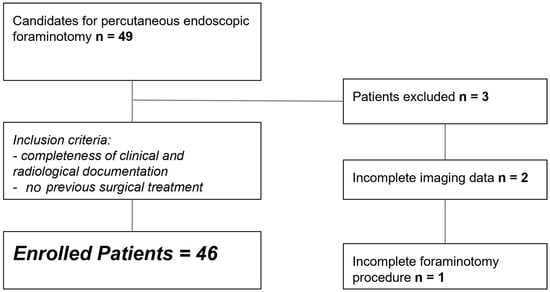
Figure 1
Open AccessCase Report
Surgical Management of Pediatric Coronoid Process Fractures: A Report of Two Cases
by
Anna Gabriella Lamberti, Aba Lőrincz, Tibor Molnár, Tamás Kassai, Hermann Nudelman and Gergő Józsa
Life 2025, 15(4), 614; https://doi.org/10.3390/life15040614 (registering DOI) - 6 Apr 2025
Abstract
Coronoid process fractures in the pediatric population are rare and often misdiagnosed, leading to chronic elbow instability. We aim to evaluate the surgical management of two adolescent cases of inveterate coronoid fractures using autologous bone grafting. Both patients, with a history of recurrent
[...] Read more.
Coronoid process fractures in the pediatric population are rare and often misdiagnosed, leading to chronic elbow instability. We aim to evaluate the surgical management of two adolescent cases of inveterate coronoid fractures using autologous bone grafting. Both patients, with a history of recurrent elbow dislocations, presented with pseudoarthrosis and were initially misdiagnosed due to minor or subtle fractures. Comprehensive imaging, including computed tomography (CT) and magnetic resonance imaging (MRI), confirmed the presence of significant coronoid defects. The surgical intervention involved employing autografts from the iliac wing to reconstruct the coronoid process, followed by fixation with screws. Both patients underwent postoperative rehabilitation via physiotherapy, resulting in full functional recovery. At their one-year follow-ups, both patients regained full elbow function, achieving range-of-motion measurements of 0–0–130° flexion–extension and 90–0–90° pronation–supination; no recurrence of instability was reported, with no complications at the yearly follow-ups. This approach demonstrates the efficacy of autograft reconstruction in restoring elbow stability, particularly in cases with substantial bone loss or pseudoarthrosis. Our study highlights the importance of advanced imaging and individualized treatment strategies, emphasizing that early surgical intervention can prevent long-term disability in pediatric patients with chronic coronoid fractures.
Full article
(This article belongs to the Special Issue Advanced Strategies in Fracture Treatments)
►▼
Show Figures

Figure 1
Open AccessSystematic Review
Compliance and Adherence to Pelvic Floor Exercise Therapy in People with Pelvic Floor Disorders: A Systematic Review and Meta-Analysis
by
Inmaculada Villa-Del-Pino, José-Jesús Jiménez-Rejano, Manuel Rebollo-Salas, Álvaro-José Rodríguez-Domínguez and Carmen-María Suárez-Serrano
Life 2025, 15(4), 613; https://doi.org/10.3390/life15040613 (registering DOI) - 6 Apr 2025
Abstract
Background: The impact of muscle-training treatment on quality of life and functional outcomes in people with pelvic floor dysfunction may be related to adherence rates. Methods: Nine electronic databases were searched for studies published up to 15 October 2024. A qualitative synthesis was
[...] Read more.
Background: The impact of muscle-training treatment on quality of life and functional outcomes in people with pelvic floor dysfunction may be related to adherence rates. Methods: Nine electronic databases were searched for studies published up to 15 October 2024. A qualitative synthesis was used to describe the relationship between adherence or compliance with treatment, quality of life, and symptomatic severity. A meta-analysis of data from selected studies was performed that assessed quality of life and symptomatic severity in the short term. Results: Seven studies with 2190 participants were included. Of these studies, 42% showed rates greater than 80% in terms of adherence. A beneficial effect was found in terms of urinary incontinence severity without statistical differences between the groups (p = 0.813), while quality of life showed statistically significant improvements favoring the experimental group (p = 0.036). The quality of the evidence was collected or measured from low to high. Conclusions: People with pelvic floor disorders show high rates of adherence to pelvic floor muscle exercise and experience an improved quality of life in the short term, but more research is needed on the design of homogeneous systems to measure compliance and adherence to exercise-based treatments.
Full article
(This article belongs to the Special Issue Innovative Perspectives in Physical Therapy and Health)
►▼
Show Figures

Figure 1
Open AccessArticle
Impact of Depression on Health-Related Quality of Life in Ulcerative Colitis Patients—Are We Doing Enough? A Single Tertiary Center Experience
by
Dunja Jaksic, Sasa Vuksanovic, Aleksandar Toplicanin, Jelena Spiric-Milovancevic, Gorica Maric and Aleksandra Sokic-Milutinovic
Life 2025, 15(4), 612; https://doi.org/10.3390/life15040612 (registering DOI) - 6 Apr 2025
Abstract
Ulcerative colitis (UC) significantly impacts patients’ health-related quality of life (HRQOL). This study aimed to evaluate HRQOL and the factors affecting it, and the prevalence of anxiety, depression and alexythimia in patients with UC. This cross-sectional study included 248 UC patients (21 with
[...] Read more.
Ulcerative colitis (UC) significantly impacts patients’ health-related quality of life (HRQOL). This study aimed to evaluate HRQOL and the factors affecting it, and the prevalence of anxiety, depression and alexythimia in patients with UC. This cross-sectional study included 248 UC patients (21 with proctitis, 63 with left-sided UC and 164 with extensive colitis). Data were collected using standardized self-administered questionnaires [a socio-demographic questionnaire, General Anxiety Disorder-7 (GAD-7), the Patient Health Questionnaire-9 (PHQ-9), the Toronto Alexithymia Scale (TAS-20) and the Short Inflammatory Bowel Disease Questionnaire (SIBDQ)]. Clinical data on remission status, extraintestinal manifestations, comorbidities and the use of advanced therapies were also collected. Hierarchical regression analysis of variables predicting SIBDQ score was done. Clinical and laboratory remission was present in 95.6% of the patients. The prevalences of depression, anxiety and alexithymia were 44.7%, 34.3% and 30.2%, respectively. There were no differences in the PHQ-9, GAD-7 and TAS-20 scores in relation to remission status. The average SIBDQ score was 56.5. The patients in remission reported better SIBDQ scores compared to the symptomatic patients (p = 0.002). The hierarchical regression analysis showed that remission of disease and a higher depression score influenced HRQOL in the UC patients. The prevalence of depression, anxiety and alexithymia in the UC patients was high. Remission of disease and a high depression score were the main factors related to HRQOL.
Full article
(This article belongs to the Special Issue Gastrointestinal Health: Clinical Research and Therapeutic Innovations)
►▼
Show Figures
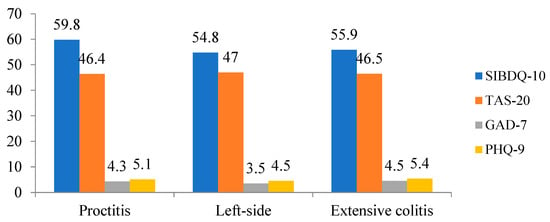
Figure 1
Open AccessArticle
Disrupted Redox Regulation and Inflammatory Response in Pyoderma Gangrenosum
by
Simona Roxana Georgescu, Clara Matei, Corina Daniela Ene, Cristina Capusa, Mircea Tampa, Madalina Irina Mitran, Cristina Iulia Mitran, Gheorghe Nicolae and Ilinca Nicolae
Life 2025, 15(4), 611; https://doi.org/10.3390/life15040611 (registering DOI) - 6 Apr 2025
Abstract
Introduction. The pathophysiology of Pyoderma Gangrenosum (PG) involves altered innate and adaptive immunity, mutagenic and epigenetic changes, the autoinflammatory state, and the overexpression of cytokines. This study investigated the potential contribution of inflammation, redox signaling, and the immune system in the pathogenesis of
[...] Read more.
Introduction. The pathophysiology of Pyoderma Gangrenosum (PG) involves altered innate and adaptive immunity, mutagenic and epigenetic changes, the autoinflammatory state, and the overexpression of cytokines. This study investigated the potential contribution of inflammation, redox signaling, and the immune system in the pathogenesis of PG. Materials and Methods. This case–control study included 36 patients with PG and 30 controls. We have determined the serum concentrations of acute phase proteins (C-reactive protein—CRP, alpha1 glycoprotein acid—AGPA, Albumin), interleukin-17A -IL-17A, β2 microglobulin-β2MG, reduced glutathione-GSH, oxidized glutathione- GSSG, the GSH/GSSG ratio, and hematological parameters (white blood cells-WBC, neutrophil-lymphocyte ratio-NLR, erythrocyte sedimentation rate-ESR) in patients with PG compared with controls. Furthermore, we have evaluated the variations in these markers before and after treatment in PG patients. Results. The serum concentrations of acute phase proteins (CRP, AGPA, and Albumin) and the IL-17A, β2MG, GSH, GSSG, and GSH/GSSG ratio were significantly different between the PG group and controls. Hematological parameters (WBC, NLR, and ESR), acute phase proteins (CRP, AGPA, and albumin), and IL-17A showed an exaggerated and persistent inflammatory response in patients with PG. In patients with PG associated with systemic diseases, the dysregulation of the biochemical events was more severe. Conclusions. The acute phase proteins, β2MG-MHC class I complex, and the GSH-GSSG system are unbalanced in PG. Our results could improve the diagnosis and our understanding of the pathogenic basis of PG.
Full article
(This article belongs to the Special Issue Skin Diseases and Dermatologic Comorbidities)
►▼
Show Figures

Figure 1
Open AccessArticle
Physiological Parameters of Sleep and the Risk of Obstructive Sleep Apnea in Competitive Athletes with Poor Sleep Quality
by
Feng-Yin Chen, Yung-An Tsou, Nai-Jen Chang and Wen-Dien Chang
Life 2025, 15(4), 610; https://doi.org/10.3390/life15040610 (registering DOI) - 6 Apr 2025
Abstract
This study aimed to explore the sleep conditions and obstructive sleep apnea (OSA) risk in athletes with poor sleep quality. Athletes with poor sleep quality before competition were recruited. Cardiopulmonary coupling analysis, the Pittsburgh Sleep Quality Index, Epworth Sleepiness Scale, and Insomnia Severity
[...] Read more.
This study aimed to explore the sleep conditions and obstructive sleep apnea (OSA) risk in athletes with poor sleep quality. Athletes with poor sleep quality before competition were recruited. Cardiopulmonary coupling analysis, the Pittsburgh Sleep Quality Index, Epworth Sleepiness Scale, and Insomnia Severity Index were used to assess and compare athletes at risk of OSA (apnea-hypopnea index (AHI) ≥ 5 events per hour) with those not at risk (AHI < 5 events per hour). Comparisons were made between the non-OSA group (n = 23) and the OSA risk group (n = 19, AHI = 10.79 ± 4.47 events per hour). The OSA risk group exhibited a significantly higher percentage of Stage 1 (S1) and Stage 2 (S2) sleep and greater heart rate variability (HRV) (p < 0.05). Positive correlations were found between AHI and the percentage of S1 and S2 sleep, low-frequency (LF), and the LF/HF ratio (p < 0.05). Conversely, significant negative correlations were observed between AHI and the percentage of Stage 3 (S3) and Stage 4 (S4) sleep, as well as HRV (p < 0.05). Athletes with poor sleep quality and high OSA risk demonstrated reduced parasympathetic activity, increased sympathetic activity, and affected sympathovagal balance during nocturnal HRV.
Full article
(This article belongs to the Special Issue Obstructive Sleep Apnea and Related Disorders: Pathophysiological Traits and Strategies for Treatment)
►▼
Show Figures

Figure 1
Open AccessArticle
A Prospective Controlled Study on the Longitudinal Effects of Rehabilitation in Older Women with Primary Sarcopenia
by
Bianca Maria Vladutu, Daniela Matei, Anca Maria Amzolini, Constantin Kamal and Magdalena Rodica Traistaru
Life 2025, 15(4), 609; https://doi.org/10.3390/life15040609 (registering DOI) - 6 Apr 2025
Abstract
Sarcopenia, defined as a progressive loss of skeletal muscle mass, strength, and function, is a leading contributor to disability, dependence, and reduced quality of life (HRQoL) in older adults. This study aimed to evaluate the impact of a personalized six-month rehabilitation program, centered
[...] Read more.
Sarcopenia, defined as a progressive loss of skeletal muscle mass, strength, and function, is a leading contributor to disability, dependence, and reduced quality of life (HRQoL) in older adults. This study aimed to evaluate the impact of a personalized six-month rehabilitation program, centered on tailored kinetic therapy, on physical performance and HRQoL in older women with primary sarcopenia. Methods: This prospective controlled study included 80 women aged ≥65 years, allocated into a Study Group (SG, n = 40), who followed a supervised personalized kinetic program, and a control group (CG, n = 40), who received general advice regarding physical activity and nutrition. Physical performance was measured using the short physical performance battery (SPPB), while HRQoL was assessed with the disease-specific SarQoL questionnaire. Evaluations were conducted at baseline and after six months. Results: At baseline, both groups had comparable scores (SPPB: SG = 5.75 ± 0.86 vs. CG = 5.8 ± 0.88, p = 0.798; SarQoL: SG = 54.42 ± 8.76 vs. CG = 55.59 ± 4.61, p = 0.457). After six months, the SG showed significant improvements (SPPB = 8.05 ± 0.90, p < 0.001; SarQoL = 62.55 ± 7.00, p < 0.001). Significant gains were observed in domains related to physical and mental health, locomotion, functionality, and leisure activities (p < 0.05). In contrast, the CG showed only minor, non-significant changes (SPPB = 6.17 ± 0.78; SarQoL = 56.51 ± 5.51). Conclusions: A structured, personalized kinetic program significantly improves physical performance and HRQoL in older women with primary sarcopenia. These results support the need for individualized, supervised rehabilitation programs in optimizing functional recovery and enhancing patient-centered outcomes in sarcopenia management.
Full article
(This article belongs to the Special Issue Muscle Wasting, Aging, and Cancer: The Effects of Physical Exercise)
►▼
Show Figures

Figure 1
Open AccessArticle
An Ignored Population in Emergency Department: Cardio-Oncology Patients
by
Ömer Salt, Cafer Zorkun and Semra Aytürk Salt
Life 2025, 15(4), 608; https://doi.org/10.3390/life15040608 (registering DOI) - 6 Apr 2025
Abstract
Background: The aim of this study was to analyze cancer patients who were admitted to the emergency department with cardiac symptoms and hospitalized in the cardiology service or cardiology intensive care unit. Methods: One hundred and thirty-one cancer patients who were hospitalized in
[...] Read more.
Background: The aim of this study was to analyze cancer patients who were admitted to the emergency department with cardiac symptoms and hospitalized in the cardiology service or cardiology intensive care unit. Methods: One hundred and thirty-one cancer patients who were hospitalized in the period of 5 years were included in the study. Age, sex, type of cancer, treatment, emergency department diagnosis, laboratory parameters, and in-hospital outcomes were evaluated. Results: The most common hospitalization diagnosis was acute coronary syndromes (69.5%, n = 91). The mortality rate was 14.5% (n = 19). The NTproBNP levels were found to be higher in all patients, and especially high in patients with LVEF < 40%. Conclusions: Cancer patients with low LVEF and elevated NTproBNP levels and increased HEART and TIMI scores have increased risk for cardiac toxicity and mortality. This patient group should be treated and followed-up with great care.
Full article
(This article belongs to the Special Issue Management of Ischemia and Heart Failure—2nd Edition)
Open AccessArticle
3D Spheroid Cultures for Salivary Gland Tissue Engineering: Effects of Fibroblast on Epithelial Cell Function
by
Lan Thi Phuong Nguyen, Joo Hyun Kim, Jiwon Son, Sung Sik Hur, Minyong Lee, Hyung Kwon Byeon, Jin-Young Kim, Myung Jin Ban, Joo Hyun Kim, Man Ryul Lee, Jae Hong Park and Yongsung Hwang
Life 2025, 15(4), 607; https://doi.org/10.3390/life15040607 (registering DOI) - 5 Apr 2025
Abstract
Three-dimensional (3D) spheroid cultures are crucial for modeling salivary gland (SG) morphogenesis and advancing regenerative medicine. This study evaluated the effects of varying ratios of mouse SG-derived epithelial cells co-cultured with human dermal fibroblasts (hDFs), identifying a 2:1 ratio (spheroids containing 67% EpCAM
[...] Read more.
Three-dimensional (3D) spheroid cultures are crucial for modeling salivary gland (SG) morphogenesis and advancing regenerative medicine. This study evaluated the effects of varying ratios of mouse SG-derived epithelial cells co-cultured with human dermal fibroblasts (hDFs), identifying a 2:1 ratio (spheroids containing 67% EpCAMpos cells with 33% hDFs) as optimal for preserving native SG-derived epithelial cell phenotypes. At this ratio, 67% EpCAMpos spheroids maintained structural integrity and demonstrated a significant reduction in apoptosis and senescence markers, specifically, cleaved caspase-3 (Cc3) and Serpine1, alongside an enhanced expression of the progenitor marker Keratin 5 (KRT5). This highlights the pivotal role of fibroblasts in supporting epithelial cell function in 3D cultures. These spheroids provide a useful model for developing SG tissues that closely mimic physiological properties. Despite promising results, these findings are preliminary and require further validation under diverse conditions and across different SG models.
Full article
(This article belongs to the Special Issue New Restorative Technologies in the Management and Characterization Techniques of the Hard and Soft Tissues of Oral Cavity)
►▼
Show Figures

Figure 1
Open AccessArticle
A Combined Approach Using T2*-Weighted Dynamic Susceptibility Contrast MRI Perfusion Parameters and Radiomics to Differentiate Between Radionecrosis and Glioma Progression: A Proof-of-Concept Study
by
José Pablo Martínez Barbero, Francisco Javier Pérez García, David López Cornejo, Marta García Cerezo, Paula María Jiménez Gutiérrez, Luis Balderas, Miguel Lastra, Antonio Arauzo-Azofra, José M. Benítez and Antonio Jesús Láinez Ramos-Bossini
Life 2025, 15(4), 606; https://doi.org/10.3390/life15040606 (registering DOI) - 5 Apr 2025
Abstract
Differentiating tumor progression from radionecrosis in patients with treated brain glioma represents a significant clinical challenge due to overlapping imaging features. This study aimed to develop and evaluate a machine learning model that integrates radiomics features and T2*-weighted Dynamic Susceptibility Contrast MRI perfusion
[...] Read more.
Differentiating tumor progression from radionecrosis in patients with treated brain glioma represents a significant clinical challenge due to overlapping imaging features. This study aimed to develop and evaluate a machine learning model that integrates radiomics features and T2*-weighted Dynamic Susceptibility Contrast MRI perfusion (DSC MRI) parameters to improve diagnostic accuracy in distinguishing these entities. A retrospective cohort of 46 patients (25 with confirmed radionecrosis, 21 with glioma progression) was analyzed. From lesion segmentation on DSC MRI, 851 radiomics features were extracted using PyRadiomics, alongside seven perfusion parameters (e.g., relative cerebral blood volume, time to peak) obtained from time–intensity curves (TICs). These features were combined into a single dataset and 14 classification algorithms were evaluated with GroupKFold cross-validation (k = 4). The top-performing model was selected based on predictive area under the curve (AUC) yield. The Logistic Regression classifier achieved the highest performance, with an AUC of 0.88, followed by multilayer perceptron and AdaBoost with AUC values of 0.85 and 0.79, respectively. The precision values were 72%, 74%, and 78% for the three models, respectively, while the accuracy was 63%, 70%, and 71%. Key predictive variables included radiomics features like wavelet-HHH_firstorder_Mean and mean normalized TIC values. Our combined approach integrating radiomics and DSC MRI parameters shows strong potential for distinguishing radionecrosis from glioma progression. However, further validation with larger cohorts is essential to confirm the generalizability of this approach.
Full article
(This article belongs to the Section Medical Research)
►▼
Show Figures
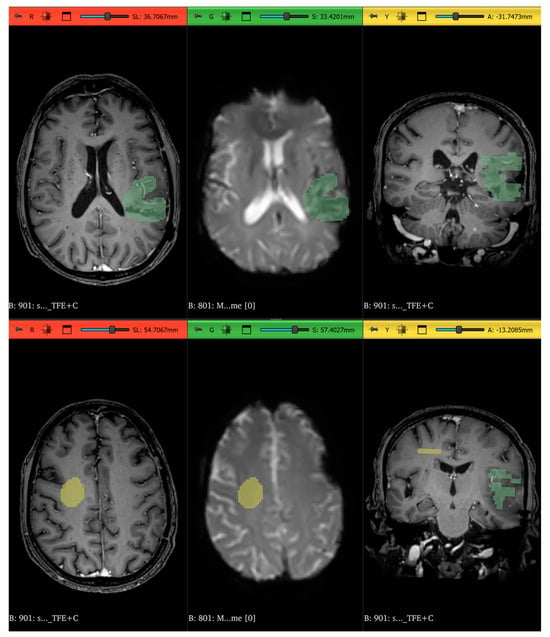
Figure 1
Open AccessArticle
A Prospective Pilot Study for Prognosis of Cardiac Resynchronization Therapy Super-Response Using Electrical and Mechanical Dyssynchrony Assessment in Patients with Heart Failure and Strauss Left Bundle Branch Block Criteria
by
Tariel Atabekov, Andrey Smorgon, Anna Mishkina, Sergey Krivolapov, Svetlana Sazonova, Mikhail Khlynin, Roman Batalov and Sergey Popov
Life 2025, 15(4), 605; https://doi.org/10.3390/life15040605 (registering DOI) - 5 Apr 2025
Abstract
Electrical and mechanical dyssynchrony (MD) underlies left ventricular (LV) contractile dysfunction in patients with heart failure (HF) and left bundle branch block (LBBB). In some cases, cardiac resynchronization therapy (CRT) almost completely reverses LV contractile dysfunction. The LBBB electrocardiographic Strauss criteria and MD
[...] Read more.
Electrical and mechanical dyssynchrony (MD) underlies left ventricular (LV) contractile dysfunction in patients with heart failure (HF) and left bundle branch block (LBBB). In some cases, cardiac resynchronization therapy (CRT) almost completely reverses LV contractile dysfunction. The LBBB electrocardiographic Strauss criteria and MD assessment were proposed to improve CRT response. However, using these techniques separately does not improve LV contraction in 20–40% of patients after CRT device implantation. We aimed to evaluate whether the combined use of electrocardiography (ECG), speckle-tracking echocardiography (STE) and cardiac scintigraphy could improve the prognosis of CRT super-response in patients with HF and Strauss LBBB criteria during a 6-month follow-up period. The study prospectively included patients with HF, classified as New York Heart Association (NYHA) functional class (FC) II–III in sinus rhythm with Strauss LBBB criteria and reduced left ventricular ejection fraction (LVEF). Before and 6 months after CRT device implantation, ECG, STE and cardiac scintigraphy were performed. The study’s primary endpoint was the NYHA class improvement ≥ 1 and left ventricle end systolic volume decrease > 30% or LVEF improvement > 15% after 6 months of CRT. Based on collected data, we developed a prognostic model regarding the CRT super-response. Out of 54 (100.0%) patients, 39 (72.2%) had a CRT super-response. Patients with CRT super-response were likelier to have a greater S wave amplitude in V2 lead (p = 0.004), higher rates of global longitudinal strain (GLS) (p = 0.001) and interventricular delay (IVD) (p = 0.005). Only three indicators (S wave amplitude in V2 lead, GLS and IVD) were independently associated with CRT super-response in univariable and multivariable logistic regression. We created a prognostic model based on the logistic equation and calculated a cut-off value (>0.73). The resulting ROC curve revealed a discriminative ability with an AUC of 0.957 (sensitivity 87.2%; specificity 100.0%). The electrical and mechanical dyssynchrony assessment using ECG, STE and cardiac scintigraphy is useful in the prediction of CRT super-response in patients with HF and Strauss LBBB criteria during a 6-month follow-up period. Our prognostic model can identify patients who are super-responders to CRT.
Full article
(This article belongs to the Special Issue Management of Ischemia and Heart Failure—2nd Edition)
►▼
Show Figures
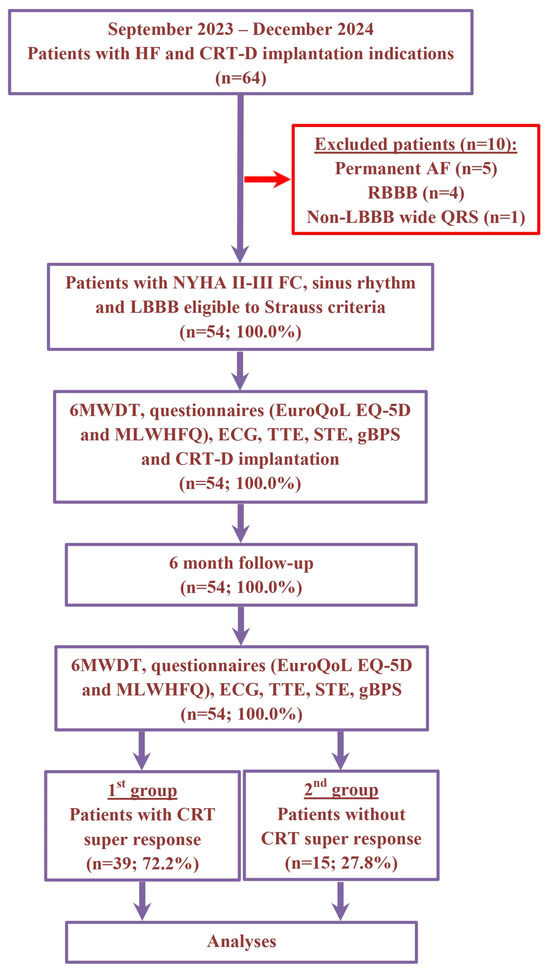
Figure 1
Open AccessArticle
Is It Possible to Accurately Evaluate the Tumor Bed After Neoadjuvant Chemotherapy Using a 14G Tru-Cut Biopsy?
by
Berkay Kilic, Suleyman Bademler, Burak Ilhan, Inci Kizildag Yirgin, Ravza Yilmaz, Aysel Bayram and Hasan Karanlik
Life 2025, 15(4), 604; https://doi.org/10.3390/life15040604 (registering DOI) - 5 Apr 2025
Abstract
Background/Objectives: Accurately identifying residual disease in the breast following neoadjuvant systemic therapy (NST) is a critical aspect of treatment planning. While surgery remains the standard treatment, its omission may be considered in exceptional responders. However, this strategy is still under investigation and carries
[...] Read more.
Background/Objectives: Accurately identifying residual disease in the breast following neoadjuvant systemic therapy (NST) is a critical aspect of treatment planning. While surgery remains the standard treatment, its omission may be considered in exceptional responders. However, this strategy is still under investigation and carries local and distant recurrence risks. No definitive method currently exists to confirm pathologic complete response (pCR) after NST. This study evaluates the reliability of ultrasound-guided 14G Tru-Cut biopsy in assessing post-NST disease status. Methods: Data from 204 breast cancer patients who underwent ultrasound-guided 14G Tru-Cut biopsy before surgery at Istanbul University Oncology Institute (March 2015–May 2024) were analyzed. Concordance between Tru-Cut biopsy and final pathology was assessed, along with diagnostic accuracy parameters, including false-negative rate (FNR), accuracy, negative predictive value (NPV), and positive predictive value (PPV). Results: The median patient age was 45 years (range: 26–86). The median initial tumor size was 32 mm, reducing to 10 mm post-treatment. Pathologic complete response (pCR) was 33.8% in surgical specimens and 40.7% in biopsy samples. Biopsy misdiagnosed 15 patients, with an overall FNR of 11.1% and accuracy of 92.2% (95% CI, 7.1–18.1%; 95% CI, 87.6–95.5%). Among patients with radiologic complete response (rCR) (n = 99), FNR was 25.8%, and accuracy was 92.1%. The best outcomes were in the rCR and Tru-Cut pCR subgroup, with an FNR of 5.9% and accuracy of 95.6%. In triple-negative breast cancer patients, FNR was 5%, and an accuracy was 97.4%. Conclusions: Although obtaining eight or more samples with a 14G Tru-Cut biopsy after NST is insufficient to alter clinical practice for detecting residual disease, the promising results observed in the rCR and Tru-Cut pCR subgroups suggest its potential role in guiding treatment strategies.
Full article
(This article belongs to the Section Medical Research)
Open AccessArticle
Rapid and Accurate Genotoxicity Assessment Using the Neutral Comet Assay in Cyprinus carpio Cells
by
Byeonghyeon So, Ji Ho Park, Minseon Kim, Hojun Lee, Jee Hee Yoon, Yoo Jin Lee, Duyeol Kim, Hyung Wook Kwon, Jihae Park, Taejun Han, Yun Haeng Lee and Joon Tae Park
Life 2025, 15(4), 603; https://doi.org/10.3390/life15040603 (registering DOI) - 4 Apr 2025
Abstract
Genotoxins cause significant damage to the genetic material of aquatic organisms, requiring rapid and accurate assessment. Fish-derived cells sensitive to genotoxins have proven to be a useful tool for measuring genotoxicity, but the long treatment times required for measurement limit their application in
[...] Read more.
Genotoxins cause significant damage to the genetic material of aquatic organisms, requiring rapid and accurate assessment. Fish-derived cells sensitive to genotoxins have proven to be a useful tool for measuring genotoxicity, but the long treatment times required for measurement limit their application in situations requiring rapid testing. Previous studies have shown that fish cells can be kept unstarved for up to 6 h using media containing 1% FBS. In this study, the 1% FBS/6 h parameter was used for genotoxicity assessment. Therefore, genotoxicity assessment was performed after only 6 h of genotoxin treatment in a medium containing 1% FBS. The new genotoxicity assessment method provided faster and more accurate genotoxicity data for climbazole and metolachlor than the existing assessment system using the 15% FBS/96 h parameter. Furthermore, these advantages of the new platform enabled the determination of the genotoxicity of various genotoxins, such as dibenz[a,h]anthracene and ethoprophos. In summary, we have developed a genotoxicity assessment that can generate genotoxicity data rapidly and accurately. This new platform will serve as a foundation for rapid genotoxicity assessment of many genotoxins.
Full article
(This article belongs to the Special Issue Assessments of Bioactive and Toxic Substances in Cellular and Animal Models)
►▼
Show Figures
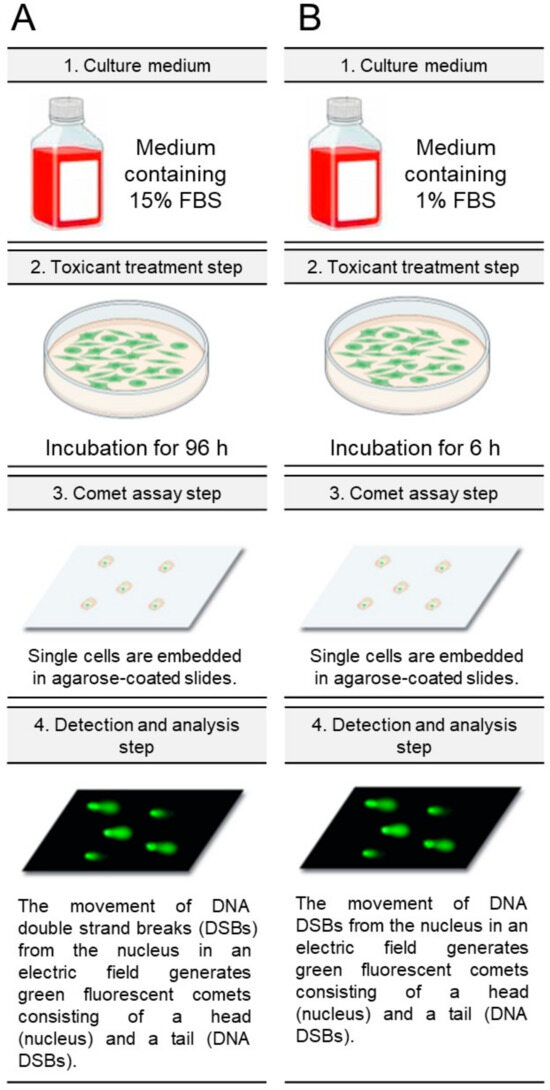
Figure 1
Open AccessReview
Risk of Permanent Corneal Injury in Microgravity: Spaceflight-Associated Hazards, Challenges to Vision Restoration, and Role of Biotechnology in Long-Term Planetary Missions
by
Jainam Shah, Joshua Ong, Ryung Lee, Alex Suh, Ethan Waisberg, C. Robert Gibson, John Berdahl and Thomas H. Mader
Life 2025, 15(4), 602; https://doi.org/10.3390/life15040602 (registering DOI) - 4 Apr 2025
Abstract
Human space exploration presents an unparalleled opportunity to study life in extreme environments—but it also exposes astronauts to physiological stressors that jeopardize key systems like vision. Corneal health, essential for maintaining precise visual acuity, is threatened by microgravity-induced fluid shifts, cosmic radiation, and
[...] Read more.
Human space exploration presents an unparalleled opportunity to study life in extreme environments—but it also exposes astronauts to physiological stressors that jeopardize key systems like vision. Corneal health, essential for maintaining precise visual acuity, is threatened by microgravity-induced fluid shifts, cosmic radiation, and the confined nature of spacecraft living environments. These conditions elevate the risk of corneal abrasions, infections, and structural damage. In addition, Spaceflight-Associated Neuro-Ocular Syndrome (SANS)—while primarily affecting the posterior segment—has also been potentially linked to anterior segment alterations such as corneal edema and tear film instability. This review examines these ocular challenges and assesses current mitigation strategies. Traditional approaches, such as terrestrial eye banking and corneal transplantation, are impractical for spaceflight due to the limited viability of preserved tissues, surgical complexities, anesthetic risks, infection potential, and logistical constraints. The paper explores emerging technologies like 3D bioprinting and stem cell-based tissue engineering, which offer promising solutions by enabling the on-demand production of personalized corneal constructs. Complementary advancements, including adaptive protective eyewear, bioengineered tear substitutes, telemedicine, and AI-driven diagnostic tools, also show potential in autonomously managing ocular health during long-duration missions. By addressing the complex interplay of environmental stressors and biological vulnerabilities, these innovations not only safeguard astronaut vision and mission performance but also catalyze new pathways for regenerative medicine on Earth. The evolution of space-based ophthalmic care underscores the dual impact of space medicine investments across planetary exploration and terrestrial health systems.
Full article
(This article belongs to the Special Issue Space Medicine Ophthalmology: Insights from Molecular Observations to the Clinical Management of Ocular Risks in Microgravity)
►▼
Show Figures

Figure 1
Open AccessCase Report
Femoral Fracture in Pregnancy: A Case Report and Review of Data from the Literature
by
Ștefan-Dragoș Tîrnovanu, Elena Cojocaru, Bogdan Veliceasa, Norin Forna, Adrian-Claudiu Carp, Bogdan Puha, Alexandru Filip, Awad Dmour, Dragoș-Cristian Popescu, Ovidiu Alexa, Sorana-Caterina Anton and Mihaela-Camelia Tîrnovanu
Life 2025, 15(4), 601; https://doi.org/10.3390/life15040601 - 4 Apr 2025
Abstract
Background: Orthopedic trauma during pregnancy is a rare yet complex medical challenge, impacting both maternal and fetal health. Among these, femoral fractures are particularly uncommon but require careful management to minimize maternal and fetal risks. Methods: We report the case of a 28-year-old
[...] Read more.
Background: Orthopedic trauma during pregnancy is a rare yet complex medical challenge, impacting both maternal and fetal health. Among these, femoral fractures are particularly uncommon but require careful management to minimize maternal and fetal risks. Methods: We report the case of a 28-year-old woman, gravida 4, para 3, at 40 weeks of gestation, who sustained a left mid-femoral diaphyseal fracture following a low-energy fall. A multidisciplinary team approach, including obstetric, orthopedic, anesthetic, and neonatal specialists, was employed. Preoperative imaging by X-ray was performed under lead-apron protection. The patient underwent an emergency C-section, followed by closed reduction and internal fixation with an intramedullary nail. Results: The surgical intervention was successful, with minimal radiation exposure. Postoperative management included thromboprophylaxis, calcium, vitamin D supplementation, and physiotherapy. The patient recovered well, achieving fracture healing within three months. Postpartum bone density assessment was recommended, suspecting pregnancy- and lactation-associated osteoporosis. Conclusions: Managing femoral fractures during pregnancy necessitates a balance between maternal and fetal well-being. A collaborative, multidisciplinary approach ensures optimal outcomes. Early surgical intervention, proper radiation precautions, and postpartum bone health assessment are crucial in these cases. Further research is needed to understand risk factors and preventive strategies for pregnancy-associated osteoporosis.
Full article
(This article belongs to the Special Issue Advanced Strategies in Fracture Treatments)
►▼
Show Figures

Figure 1
Open AccessArticle
Potential Effect of Root Exudates from Ten Crops on Promoting Stress Tolerance in Alfalfa (Medicago sativa) Seedlings
by
Xiaoyan Zhang, Shangli Shi, Xiaolong Li, Changning Li and Qian Li
Life 2025, 15(4), 600; https://doi.org/10.3390/life15040600 - 4 Apr 2025
Abstract
Allelopathy plays a major role in agricultural production, influencing plant protection, crop yield, and crop rotation systems. This study investigated the effects of root exudates on 3105c alfalfa (Medicago sativa) seeds and seedlings to identify crops with strong and weak allelopathic
[...] Read more.
Allelopathy plays a major role in agricultural production, influencing plant protection, crop yield, and crop rotation systems. This study investigated the effects of root exudates on 3105c alfalfa (Medicago sativa) seeds and seedlings to identify crops with strong and weak allelopathic potential. The results revealed that corn (Zea mays L.) (T1) exhibited the strongest allelopathic effects, whereas soybean (Glycine max (Linn.) Merr.) (T10) exhibited the weakest effects. T1 promoted seed germination by increasing radicle length and the simple vitality index. Both T1 and T10 promoted 3105c seedling growth and enhanced antioxidant capacity, albeit through different mechanisms. T1 primarily increased antioxidant capacity by elevating ascorbate and dehydroascorbate levels while reducing malondialdehyde content. In contrast, T10 enhanced antioxidant capacity by increasing soluble sugar and protein levels via hydroxyl free radical inhibition. These findings demonstrate that the allelopathic properties of corn effectively promote alfalfa growth by enhancing seed germination and improving physiological stress resistance.
Full article
(This article belongs to the Special Issue Plant Biotic and Abiotic Stresses 2024)
►▼
Show Figures

Figure 1
Open AccessArticle
Comparison of Three DNA Isolation Methods and Two Sequencing Techniques for the Study of the Human Microbiota
by
Julio Plaza-Díaz, Mariana F. Fernández, Federico García, Natalia Chueca, Luis Fontana and Ana I. Álvarez-Mercado
Life 2025, 15(4), 599; https://doi.org/10.3390/life15040599 - 4 Apr 2025
Abstract
Breast cancer is the most commonly diagnosed cancer in women and the second leading cause of female death. Altered interactions between the host and the gut microbiota appear to play an influential role in carcinogenesis. Several studies have shown different signatures of the
[...] Read more.
Breast cancer is the most commonly diagnosed cancer in women and the second leading cause of female death. Altered interactions between the host and the gut microbiota appear to play an influential role in carcinogenesis. Several studies have shown different signatures of the gut microbiota in patients with breast cancer compared to healthy women. Currently, there is disagreement regarding the different DNA isolation and sequencing methodologies for studies on the human microbiota, given that they can influence the interpretation of the results obtained. The goal of this work was to compare (1) three different DNA extraction strategies to minimize the impact of human DNA, and (2) two sequencing strategies (16S rRNA and shotgun) to identify discrepancies in microbiome results. We made use of breast tissue and fecal samples from both healthy women and breast cancer patients who participated in the MICROMA study (reference NCT03885648). DNA was isolated by means of mechanical lysis, trypsin, or saponin. The amount of eukaryotic DNA isolated using the trypsin and saponin methods was lower compared to the mechanical lysis method (mechanical lysis, 89.11 ± 2.32%; trypsin method, 82.63 ± 1.23%; saponin method, 80.53 ± 4.09%). In samples with a predominance of prokaryotic cells, such as feces, 16S rRNA sequencing was the most advantageous approach. For other tissues, which are expected to have a more complex microbial composition, the need for an in-depth evaluation of the multifactorial interaction between the various components of the microbiota makes shotgun sequencing the most appropriate method. As for the three extraction methods evaluated, when sequencing samples other than stool, the trypsin method is the most convenient. For fecal samples, where contamination by host DNA is low, no prior treatment is necessary.
Full article
(This article belongs to the Special Issue Microbiota in Health and Disease)
►▼
Show Figures
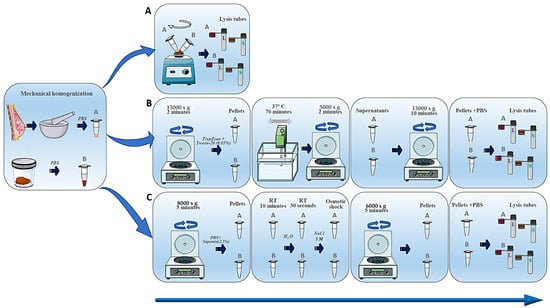
Figure 1
Open AccessArticle
A Prospective Clinical Study of Ferric Citrate Hydrate for Chronic Heart Failure with Iron Deficiency Anemia
by
Akira Sezai, Hisakuni Sekino, Makoto Taoka, Kazuaki Obata, Sakie Kanno and Masashi Tanaka
Life 2025, 15(4), 598; https://doi.org/10.3390/life15040598 - 3 Apr 2025
Abstract
Background: The efficacy of intravenous iron preparations for chronic heart failure with iron deficiency has been reported, but the efficacy of oral iron preparations has not been demonstrated. In this study, we conducted a prospective clinical study using ferric citrate hydrate tablets in
[...] Read more.
Background: The efficacy of intravenous iron preparations for chronic heart failure with iron deficiency has been reported, but the efficacy of oral iron preparations has not been demonstrated. In this study, we conducted a prospective clinical study using ferric citrate hydrate tablets in patients with chronic heart failure complicated by iron deficiency anemia. Methods and Results: A prospective study was conducted using ferric citrate hydrate in patients with chronic heart failure complicated by iron deficiency anemia. The registered patients were divided into two groups: those administered ferric citrate hydrate and those switched from iron sulfate sustained-release to ferric citrate hydrate. The primary endpoint was hemoglobin level. The secondary endpoints included hematocrit, serum iron, saturation, ferritin, and cardiac-, renal-, and hepatic-related biomarkers. A total of 141 patients were enrolled in this study, including 95 patients who were newly administered ferric citrate hydrate and 46 patients who were switched from iron sulfate sustained-release to ferric citrate hydrate. Conclusions: Ferric citrate hydrate significantly increased hemoglobin, serum iron, transferrin saturation (TSAT), and ferritin levels, and decreased atrial natriuretic peptide (ANP), brain natriuretic peptide (BNP), and N-terminal pro-brain natriuretic peptide (NT-proBNP) levels. Ferric citrate hydrate could be continued without side effects such as gastrointestinal symptoms. Improvement in iron metabolism and anemia due to iron supplementation with ferric citrate hydrate led to improvement in heart failure biomarkers.
Full article
(This article belongs to the Special Issue Advancements in Heart Failure Research)
►▼
Show Figures
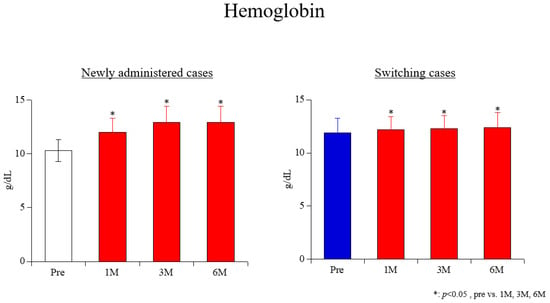
Figure 1

Journal Menu
► ▼ Journal Menu-
- Life Home
- Aims & Scope
- Editorial Board
- Reviewer Board
- Topical Advisory Panel
- Instructions for Authors
- Special Issues
- Topics
- Sections & Collections
- Article Processing Charge
- Indexing & Archiving
- Editor’s Choice Articles
- Most Cited & Viewed
- Journal Statistics
- Journal History
- Journal Awards
- Society Collaborations
- Conferences
- Editorial Office
Journal Browser
► ▼ Journal BrowserHighly Accessed Articles
Latest Books
E-Mail Alert
News
Topics
Topic in
Diversity, Geosciences, Life, Fossil Studies
Problems and Hypotheses in Palaeontology
Topic Editors: Eric Buffetaut, Julien ClaudeDeadline: 15 April 2025
Topic in
Healthcare, Hygiene, JCM, Life, Sports
Physical Exercise Impacts on Human Physical and Psychological Health
Topic Editors: Xueqiang Wang, Li Li, Li HuDeadline: 30 June 2025
Topic in
Animals, Dairy, Microorganisms, Veterinary Sciences, Metabolites, Life, Parasitologia
The Complexity of Parasites in Animals: Impacts, Innovation, and Interventions
Topic Editors: Kun Li, Rongjun Wang, Ningbo Xia, Md. F. KulyarDeadline: 31 August 2025
Topic in
Molecules, Biomimetics, Chemosensors, Life, AI, Sci
Recent Advances in Chemical Artificial Intelligence
Topic Editors: Pier Luigi Gentili, Jerzy Górecki, David C Magri, Pasquale StanoDeadline: 1 October 2025

Conferences
Special Issues
Special Issue in
Life
Plant Functional Genomics and Breeding
Guest Editor: Yifeng WangDeadline: 10 April 2025
Special Issue in
Life
Lipid Metabolism, Regulation and Biosynthesis of Microalgae
Guest Editors: Yi Xin, Fantao KongDeadline: 10 April 2025
Special Issue in
Life
Assessments of Bioactive and Toxic Substances in Cellular and Animal Models
Guest Editors: Anton Kovacik, Tomáš JamborDeadline: 15 April 2025
Special Issue in
Life
Primary Cilia in Cellular Metabolism and Development
Guest Editor: Kishor PantDeadline: 18 April 2025
Topical Collections
Topical Collection in
Life
Bacterial Infections, Treatment and Antibiotic Resistance
Collection Editor: Milan Kolář
Topical Collection in
Life
Antimicrobial Resistance
Collection Editors: Caterina Aurilio, Antonella Paladini, Pasquale Sansone, Vincenzo Pota
Topical Collection in
Life
Experimentally Testing Origin of Life Hypotheses in the Laboratory, at Field Analogs and Computationally
Collection Editor: Bruce Damer








